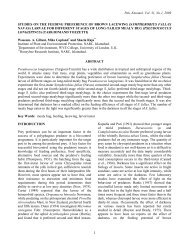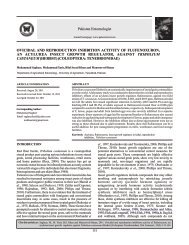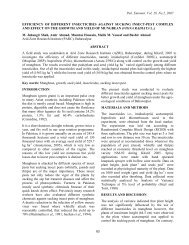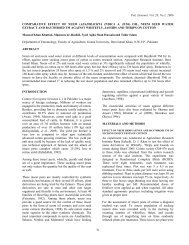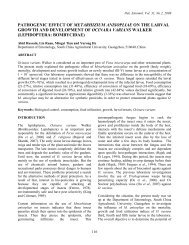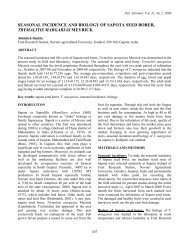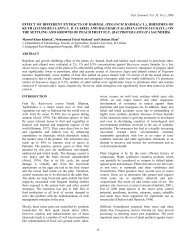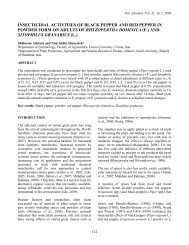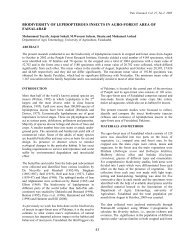diversity, species richness and evenness of moth fauna of peshawar
diversity, species richness and evenness of moth fauna of peshawar
diversity, species richness and evenness of moth fauna of peshawar
Create successful ePaper yourself
Turn your PDF publications into a flip-book with our unique Google optimized e-Paper software.
Pak. Entomol. Vol. 31, No.2, 2009<br />
DIVERSITY, SPECIES RICHNESS AND EVENNESS OF MOTH FAUNA OF<br />
PESHAWAR<br />
Muhammad Aslam<br />
Department <strong>of</strong> Zoology, Islamia College University Peshawar, NWFP, Pakistan<br />
ABSTRACT<br />
Moths were collected from different parts <strong>of</strong> Peshawar during June to August in 2007 to determine their<br />
<strong>diversity</strong>, <strong>species</strong> <strong>richness</strong> <strong>and</strong> <strong>evenness</strong>. A total number <strong>of</strong> 774 <strong>moth</strong> specimens were collected by using simple<br />
light traps operated from dusk to dawn daily for sixty nights. The <strong>moth</strong>s caught were identified up to family<br />
level. Families Noctuidae, Pyralidae, Arctiidae, Geometridae, Sphingidae <strong>and</strong> Lymantriidae were represented in<br />
collection samples. The <strong>diversity</strong> index, <strong>species</strong> <strong>richness</strong> <strong>and</strong> <strong>evenness</strong> <strong>of</strong> <strong>moth</strong> <strong>fauna</strong> in Peshawar were 3.14,<br />
5.26 <strong>and</strong> 0.87, respectively.<br />
Key Words: Lepidoptera, Diversity, Pakistan, Peshawar<br />
INTRODUCTION<br />
Diversity can be defined as the number <strong>of</strong> different<br />
items <strong>and</strong> their relative frequency. For biological<br />
<strong>diversity</strong>, these items are organized at many levels,<br />
ranging from complete ecosystems to the chemical<br />
structures that are the molecular basis <strong>of</strong> heredity.<br />
Thus the term encompasses different ecosystems,<br />
<strong>species</strong>, genes <strong>and</strong> their relative abundance (OTA,<br />
1987). One characteristic attribute to multi-<strong>species</strong><br />
populations is <strong>diversity</strong>, also probably one <strong>of</strong> the<br />
most misused <strong>and</strong> incorrectly calculated attributes.<br />
Perhaps the commonest misconception is that <strong>species</strong><br />
<strong>richness</strong> <strong>and</strong> <strong>diversity</strong> are synonymous. Although<br />
related, they are distinct. Species <strong>richness</strong> is the total<br />
number <strong>of</strong> <strong>species</strong> present in a given area or sample<br />
whereas <strong>diversity</strong> takes into account how individuals<br />
are distributed amongst those <strong>species</strong>, i.e., the <strong>species</strong><br />
frequency distribution. In fact, it turns out that nearly<br />
all quantitative measures <strong>of</strong> <strong>diversity</strong> are some<br />
combination <strong>of</strong> two components, <strong>species</strong> <strong>richness</strong> <strong>and</strong><br />
<strong>evenness</strong>, where <strong>evenness</strong> describes how equally<br />
individuals are distributed amongst the <strong>species</strong>.<br />
Insects comprise more than half <strong>of</strong> the world’s<br />
known animal <strong>species</strong> (Wilson, 1992) <strong>of</strong> which the<br />
second largest <strong>and</strong> more diverse order is Lepidoptera<br />
<strong>of</strong> class Insecta (Benton, 1995). Moths <strong>and</strong> butterflies<br />
were collected <strong>and</strong> identified from different parts <strong>of</strong><br />
the Indo-Pak subcontinent (Bingham, 1905, 1907;<br />
Bell, 1919; Bell <strong>and</strong> Scot, 1937; Talbot, 1939-47; De<br />
Niceville <strong>and</strong> Marshall, 1982-90 <strong>and</strong> Mani (1986).<br />
Daniel (1965) <strong>and</strong> Elbert (1969) studied the Sphingid<br />
<strong>moth</strong>s from Iran <strong>and</strong> Afghanistan.<br />
Lepidoptera is probably one <strong>of</strong> the most suitable<br />
groups for most quantitative comparisons between<br />
insect <strong>fauna</strong>s to be valid, for the many reasons<br />
elaborated by Holloway (1980, 1984 <strong>and</strong> 1985),<br />
especially their abundance, <strong>species</strong> <strong>richness</strong>, response<br />
to vegetation <strong>and</strong> climate, their ease <strong>of</strong> sampling<br />
using light traps <strong>and</strong> relatively advanced taxonomy.<br />
Although light trapping <strong>of</strong> macrolepidoptera has been<br />
carried out widely in temperate <strong>and</strong> tropical regions<br />
throughout the world but generally results are not<br />
directly comparable between areas because <strong>of</strong><br />
different light sources, trap design, trapping periods<br />
<strong>and</strong> taxonomic coverage. A recent review by<br />
Holloway (1987) <strong>of</strong> the many light trap samples <strong>of</strong><br />
macrolepidoptera throughout the Indo-Australian<br />
tropics gave a very useful summary <strong>of</strong> the existing<br />
information from the area <strong>and</strong> suggested some<br />
general trends in relation to altitude, isolation <strong>and</strong><br />
disturbance. However, for the reasons mentioned<br />
above, results from such sample comparisons can<br />
only be tentative until more st<strong>and</strong>ardized information<br />
is available. This can be difficult, time consuming<br />
<strong>and</strong> <strong>of</strong>ten not practical in isolated areas.<br />
The main objective <strong>of</strong> this research study was to<br />
collect, identify <strong>and</strong> calculate <strong>diversity</strong>, <strong>species</strong><br />
<strong>richness</strong> <strong>and</strong> <strong>evenness</strong> <strong>of</strong> <strong>moth</strong> <strong>fauna</strong> <strong>of</strong> Peshawar<br />
region.<br />
99
Pak. Entomol. Vol. 31, No.2, 2009<br />
MATERIALS AND METHODS<br />
This study was carried out in Peshawar which is a<br />
historical city <strong>of</strong> Pakistan <strong>and</strong> is situated near the<br />
eastern end <strong>of</strong> the Khyber Pass with a total area <strong>of</strong><br />
1257 sq. km. Moths were collected by using simple<br />
light traps consisting <strong>of</strong> a plastic jar; sprinkled with a<br />
commercial insecticide “Coopex” powder<br />
(Permethrin 0.5%). The jars were covered with large<br />
plastic funnels <strong>and</strong> 200 watt tungsten bulbs were used<br />
as a light source for the traps. These traps were set up<br />
at different sites in Peshawar <strong>and</strong> were operated from<br />
dusk to dawn continuously for sixty nights from June<br />
to August 2007. Moths, caught in the traps were<br />
brought to the laboratory <strong>and</strong> were identified with the<br />
help <strong>of</strong> available literature (Hampson, 1894). In<br />
Peshawar the main vegetations are Delbergia sissoo<br />
(Shisham), Citrus acida, Duranta repens, Cupressus<br />
sempervirens, Cassia fistula <strong>and</strong> grasses etc. which<br />
constitute the major habitats <strong>of</strong> insect <strong>fauna</strong><br />
particularly <strong>moth</strong>s.<br />
Measurement <strong>of</strong> <strong>diversity</strong><br />
The type <strong>of</strong> <strong>diversity</strong> used here is α- <strong>diversity</strong> which<br />
is the <strong>diversity</strong> <strong>of</strong> <strong>species</strong> within a community or<br />
habitat. The <strong>diversity</strong> index was calculated by using<br />
the Shannon – Wiener <strong>diversity</strong> index (1949).<br />
Diversity index = H = – ∑ Pi In Pi<br />
where Pi = S / N<br />
S = number <strong>of</strong> individuals <strong>of</strong> one <strong>species</strong><br />
N = total number <strong>of</strong> all individuals in the sample<br />
In = logarithm to base e<br />
Measurement <strong>of</strong> <strong>species</strong> <strong>richness</strong><br />
RESULTS AND DISCUSSION<br />
During this study, a total <strong>of</strong> 774 specimens <strong>of</strong> <strong>moth</strong>s<br />
belonging to six families were collected in Peshawar<br />
by using light traps. Fig. 1 shows the number <strong>of</strong><br />
individuals belonging to each family at university<br />
campus. The highest number <strong>of</strong> <strong>moth</strong> specimens<br />
(251) belonged to family Pyralidae while family<br />
Sphingidae, with a total number <strong>of</strong> 30 <strong>moth</strong><br />
specimens, represented the minimum number. Fig. 2<br />
represents the <strong>diversity</strong> index <strong>of</strong> each family <strong>of</strong> <strong>moth</strong>s<br />
at university campus area. Family Noctuidae had the<br />
highest <strong>diversity</strong> index <strong>of</strong> 1.03 while family<br />
Sphingidae showed the lowest value with 0.18<br />
<strong>diversity</strong> index. This study indicated that the <strong>diversity</strong><br />
index, <strong>species</strong> <strong>richness</strong> <strong>and</strong> eveness <strong>of</strong> <strong>moth</strong> <strong>fauna</strong> in<br />
Peshawar were 3.14, 5.26 <strong>and</strong> 0.87 respectively.<br />
Although the number <strong>of</strong> individuals belonging to<br />
family Pyralidae were more than family Noctuidae<br />
but the <strong>diversity</strong> index <strong>of</strong> the latter was more<br />
suggesting more <strong>species</strong> <strong>diversity</strong> than that <strong>of</strong> family<br />
Pyralidae.<br />
Fig.1. Number <strong>of</strong> individuals <strong>of</strong> each family <strong>of</strong><br />
<strong>moth</strong>s caught by light traps in Peshawar.<br />
Margalef’s index was used as a simple measure <strong>of</strong><br />
<strong>species</strong> <strong>richness</strong> (Margalef, 1958).<br />
Margalef’s index = (S – 1) / In N<br />
S = total number <strong>of</strong> <strong>species</strong><br />
N = total number <strong>of</strong> individuals in the sample<br />
In = natural logarithm<br />
Measurement <strong>of</strong> <strong>evenness</strong><br />
For calculating the <strong>evenness</strong> <strong>of</strong> <strong>species</strong>, the Pielou’s<br />
Evenness Index (e) was used (Pielou, 1966).<br />
e = H / In S<br />
H = Shannon – Wiener <strong>diversity</strong> index<br />
S = total number <strong>of</strong> <strong>species</strong> in the sample<br />
Fig.2. Diversity index <strong>of</strong> each family <strong>of</strong> <strong>moth</strong>s<br />
caught by light traps in Peshawar.<br />
100
Pak. Entomol. Vol. 31, No.2, 2009<br />
The bio<strong>diversity</strong> (<strong>diversity</strong> index, <strong>species</strong> <strong>richness</strong><br />
<strong>and</strong> <strong>evenness</strong>) <strong>of</strong> <strong>moth</strong> <strong>fauna</strong> in Peshawar is mainly<br />
due to the rich vegetation in this area as vegetation<br />
plays an important role for the existence <strong>of</strong> insect<br />
<strong>fauna</strong> in a community as it provides the main source<br />
<strong>of</strong> food etc. for insects. For instance, the occurrence<br />
<strong>of</strong> a rich <strong>and</strong> diversified <strong>fauna</strong> in some parts <strong>of</strong><br />
Nilgiri Biosphere region was largely attributed to the<br />
conservation <strong>of</strong> forests in this region (Larsen, 1987).<br />
Conservation <strong>of</strong> the natural habitats is very essential<br />
for the existence <strong>of</strong> many <strong>species</strong> <strong>of</strong> lepidopterans.<br />
The survival <strong>of</strong> a large number <strong>of</strong> endemic <strong>species</strong> in<br />
a community or habitat warrants frequent monitoring<br />
<strong>of</strong> the ecological processes besides adoption <strong>of</strong><br />
appropriate conservation strategies in order to<br />
safeguard its rich genetic <strong>diversity</strong> (Mathew <strong>and</strong><br />
Rahmatullah, 1993).<br />
The total number <strong>of</strong> individuals caught in a trap is an<br />
indication <strong>of</strong> biomass although more care has to be<br />
taken in its interpretation than for <strong>diversity</strong> as the size<br />
<strong>of</strong> a light trap catch can be influenced significantly by<br />
the setting <strong>of</strong> the trap, interference from other lights<br />
<strong>and</strong> lunar cycles (Barlow <strong>and</strong> Woiwod, 1989).<br />
This work was an attempt to describe some aspects <strong>of</strong><br />
bio<strong>diversity</strong> <strong>of</strong> <strong>moth</strong> <strong>fauna</strong> <strong>of</strong> Peshawar. A lot <strong>of</strong><br />
further work is necessary in this regard <strong>and</strong> further<br />
collections are essential for getting a detailed periodic<br />
estimate <strong>of</strong> the <strong>fauna</strong>l <strong>diversity</strong> <strong>of</strong> <strong>moth</strong>s in this area.<br />
Ultimately it is hoped that such work may lead to the<br />
development <strong>of</strong> st<strong>and</strong>ard monitoring procedures<br />
which could be <strong>of</strong> value in assessing the<br />
environmental stability <strong>of</strong> areas under cultivation for<br />
different crops <strong>and</strong> the prediction <strong>of</strong> the effect on the<br />
structure <strong>of</strong> <strong>moth</strong> populations <strong>of</strong> tropical forest<br />
destruction (Barlow <strong>and</strong> Woiwod, 1989).<br />
REFERENCES<br />
Barlow, H. S. <strong>and</strong> I. P. Woiwod, 1989. Moth<br />
<strong>diversity</strong> <strong>of</strong> a tropical forest in Penninsular<br />
Malaysia J. Trop. Ecol., 5: 37-50.<br />
Bell, T. R. D. <strong>and</strong> F. B. Scot, 1937. Fauna <strong>of</strong> British<br />
India including Ceylon <strong>and</strong> Burma. Moths. Vol.<br />
V. Sphingidae. Taylor <strong>and</strong> Francis Ltd. London.<br />
Bell, T. R. D., 1919. The common butterflies <strong>of</strong> the<br />
plains <strong>of</strong> India (including those met within the<br />
hill stations <strong>of</strong> the Bombay Presidency). J. Bomb.<br />
Nat. Hist. Soc., 26(2): 438-487; 26(3): 750-764;<br />
26(4): 941-954.<br />
Benton, T. G., 1995. Bio<strong>diversity</strong> <strong>and</strong> biogeography<br />
<strong>of</strong> Henderson Isl<strong>and</strong> insects. Biol. J. Linn. Soc.,<br />
56(1-2): 245 – 259.<br />
Bingham, C. T., 1905. The Fauna <strong>of</strong> British-India<br />
including Ceylon <strong>and</strong> Burma. Butterflies. Vols. I<br />
<strong>and</strong> II. Taylor <strong>and</strong> Francis Ltd. London.<br />
Bingham, C. T., 1907. The Fauna <strong>of</strong> British-India<br />
including Ceylon <strong>and</strong> Burma. Butterflies. Vols. I<br />
<strong>and</strong> II. Taylor <strong>and</strong> Francis Ltd. London.<br />
Daniel, F., 1965. Osterreichische Entomologische<br />
Iran- Afghanistan-Expeditionen Beitrage Zur<br />
Lepidopteren <strong>fauna</strong>. Zeits. Wein. Ent. Ges., 50<br />
(9-10): 121-145.<br />
De Niceville, L. <strong>and</strong> G. F. L. Marshall, 1886. The<br />
Butterflies <strong>of</strong> India, Burma <strong>and</strong> Ceylon. Vol. II.<br />
Calcutta Central Press Co. Ltd., Calcutta India.<br />
Elbert, G., 1969. Afghanistan bombyces <strong>and</strong><br />
sphinges. (Sphingidae: Lepidoptera). Lich. Mus.<br />
Tierh. Dresden, 12(5): 37-63.<br />
Hampson, G. F., 1894. The <strong>fauna</strong> <strong>of</strong> British India<br />
including Ceylon <strong>and</strong> Burma. Moths. Vols. I-V,<br />
London.<br />
Holloway, J. D., 1980. Insect surveys – an approach<br />
to environmental monitoring. Atti XII Congresso<br />
Nazionale Italiano Entomologia. Roma, 1: 231-<br />
261.<br />
Holloway, J. D., 1984. The larger <strong>moth</strong>s <strong>of</strong> the<br />
Gunung Mulu National Park; a preliminary<br />
assessment <strong>of</strong> their distribution, ecology <strong>and</strong><br />
potential as environmental indicators. The<br />
Sarawak Museum Journal XXX, 51: 150-191.<br />
Holloway, J. D., 1985. Moths as indicator organisms<br />
for categorizing rain forest <strong>and</strong> monitoring<br />
changes <strong>and</strong> regeneration processes. Tropical<br />
Rain Forest: The Leeds Symposium, pp. 235-<br />
242.<br />
Holloway, J. D., 1987. Macrolepidoptera <strong>diversity</strong> in<br />
the Indo-Australian tropics: geographic, biotopic<br />
<strong>and</strong> taxonomic variations. Biol. J. Linn. Soc., 30:<br />
325-341.<br />
Larsen, T. B., 1987. The butterflies <strong>of</strong> the Nilgiri<br />
mountains <strong>of</strong> south India (Lepidoptera:<br />
101
Pak. Entomol. Vol. 31, No.2, 2009<br />
Rhopalocera). J. Bomb. Nat. Hist. Soc., 84 (1):<br />
26-54; 84 (2): 291-316; 84 (3): 560-584.<br />
Mani, M. S., 1986. Butterflies <strong>of</strong> the Himalaya.<br />
Oxford <strong>and</strong> IBH Co., New Delhi, India, 181 p.<br />
Margalef, R., 1958. Temporal succession <strong>and</strong> spatial<br />
heterogeneity in phytoplankton. In: Perspectives<br />
in Marine biology, Buzzati-Traverso (ed.), Univ.<br />
Calif. Press, Berkeley, pp. 323-347.<br />
Mathew, G. <strong>and</strong> V. K. Rahamathulla, 1993. Bio<strong>diversity</strong><br />
in the Western Ghats – a study with<br />
reference to Moths (Lepidoptera: Heterocera) in<br />
the Silent Valley National Park, India. Entomon.,<br />
20(2): 25-33.<br />
OTA (US Congress Office <strong>of</strong> Technology<br />
Assessment), 1987. Technologies to maintain<br />
biological <strong>diversity</strong>. US Government Printing<br />
Office, Washington DC.<br />
Pielou, E. C., 1966. The measurement <strong>of</strong> <strong>diversity</strong> in<br />
different types <strong>of</strong> biological collections. J.<br />
Theoret. Biol., 13: 131-144.<br />
Shannon, C. E. <strong>and</strong> W. Wiener, 1949. The<br />
mathematical theory <strong>of</strong> communication. Urbana,<br />
University <strong>of</strong> Illinois Press, 177 p.<br />
Talbot, G., 1939-1947. Fauna <strong>of</strong> British-India<br />
including Ceylon <strong>and</strong> Burma. Butterflies, Vols. I<br />
<strong>and</strong> II. Today <strong>and</strong> Tomorrow’s Printers <strong>and</strong><br />
Publishers, New Delhi, India.<br />
Wilson, E. O., 1992. Fluctuations in abundance <strong>of</strong><br />
tropical insects. Amer. Nat., 112: 1017-1045.<br />
102



